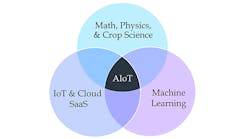While not the fanciest of gifts, I bought my household an Instant Pot. It’s a high-class pressure cooker that promises to make me a better cook.
But the kicker is that it is Wi-Fi-enabled, so it actually counts as technology, yes? That way it doesn’t count as buying an appliance but an edge IoT device. That’s my story, and I’m sticking to it.
In our sandbox, there will be a new kid in town that will change the face of Iot and IIot, and that is 5G mobile technology. I think it is pretty cool that you can monitor your pot roast from your car or turn the device on so that the pot roast is ready when you get home. 5G will make no difference in that situation.
So what will 5G give us? First off, I have done a lot of reading on 5G and its health effects. Some say that the higher frequencies will cause an abnormal amount of human disruption and cancers. You need to be the judge for yourselves, but some of the information seems quite credible. There is just as much credible information out there supporting the opposite.
At 300 GHz it will have the fastest bandwidth available and is comparable to microwaves. The short wavelength allows for very fast communications between devices, routers, switches and antennas. It just takes a shorter amount of time to travel the same distance as 4G does.
So, why all the hype? Edge devices can now process the data that they are supposed to and fire it to wherever they want using whatever protocol they want. MQTT, HTTP or even FTP can be supported by 5G much better than 4G can do it.
This gives rise to almost real-time data for SCADA, edge devices, analytical data and cloud-based solutions. The new and improved SCADA and edge-located HMI/devices will be able to link to the cloud directly using Microsoft’s Azure platform or Amazon Web Services (AWS).
5G will provide the data highway that big data will need as devices get smarter and provide more data to the user for real-time display, historical as well as real-time analytics and pre-processed information for the ability to make informed decisions.
This can be important due to the fact that most companies do not have the staff or the wherewithal to perform these analytics on their own. They will need the devices to provide this pre-processed data to them in a form that is easy to interpret.
This large amount of data will need a big transmission pipe so that the pipe doesn’t get clogged, and that’s 5G.
The 4G bandwidth simply will not be big enough to handle the data that will be required. Another 5G advantage is the ability to use smaller antennas for smaller areas and larger antennas for larger areas, which can provide long-range data support.
5G is not widely available in all areas, but, as the buildout happens, customers will start demanding more data from their systems for maintenance, operational issues and economic analytics in real time. The old proverb applies here: Work expands to fill the time available. Replace work with data and time with bandwidth, and we have created a new one.
There is a new technology that enhances the 5G core called light fidelity (Li-Fi), which is based on light waves. It is secure and not prone to interference, and it is similar to Bluetooth in its range.
This provides an ability to have a localized small, safe and fast network for devices that support Li-Fi. Fiberoptic cable could be used for connectivity, as well.
I can envision M2M being based on Li-Fi due to the non-electrical nature of the technology. While not widely used in present time, this technology may grow with the rollout of 5G.
Where 5G will excel will be when edge computing and IIoT devices start proliferating in our applications. Edge computing by definition suggests that the device that extracts and processes data and information from devices is as close to the source of the data as possible.
That data has to go somewhere, and typically it has to get there in real time, which today can be upwards of seconds or longer.
Will new SCADA/HMI systems support IIoT technologies natively to provide the need to have this data? Absolutely, and this is evident with Opto 22’s groov EPIC controller which is being marketed as an edge device with built-in HMI supporting various protocols and cloud support.
Depending on the amount of data that the customer wants from this device at the edge of the domain, the distribution model and the definition of real time, 5G may be what is needed to accomplish the goal.




